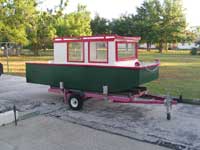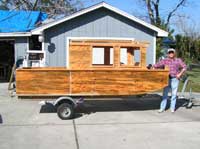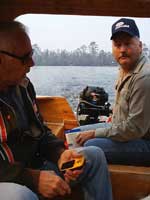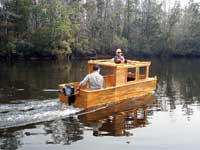|
Chuggerboat trip - November 2005 |

|
| By Pat Johnson - Pensacola,
Florida - USA |
The Chuggerboat had been inspired by a comment my
dad had made about kayaking down the Yukon River while
we were camping and fishing the Prudhoe Bay Pipeline
Road near the Arctic Circle. I responded quickly saying
I didn’t think I wanted to spend over a month
in a kayak, and that maybe we should build a bare-bones
boat with sleeping accommodations to use instead.
I further explained that we could simply donate the
boat to the Indians upon reaching the Bearing Sea
and haul the motor back on the float plane that would
bring us back to where we started. The conversation
quickly turned to other matters and neither of us
spoke about it again during the trip. Still, the idea
had not died.
 |
The Chuggerboat
had been inspired by a comment my dad
had made about kayaking down the Yukon
River.
(click
images to enlarge) |
|
After thinking about it off & on again for several
months I was pretty sure in my mind that we would
probably never haul a boat the 5000 miles (as the
crow flies) to the Yukon River from my home in Florida.
Although it was unlikely that we would ever actually
build a boat to take the trip, I had already begun
thinking about a simplistic design that would have
all the absolute necessities while at the same time
keeping the cost low enough to be able to afford to
give it away in the end. I settled on a flat bottomed
boat that would have lots of capacity for its size.
I even built a test version of the hull. I call it
the Brick since it resembled the Phil Bolger boat
design called the “Bolger Brick”). The
Brick was shorter than the ultimate project boat but
its hull shape was the same and would let us know
how the boat would handle and how stable it would
be. The Brick turned out to be extremely stable with
an extraordinary capacity for its size. The hull design
was settled in my mind.
I was now determined to build the boat even if we
didn’t take it to Alaska. However, since I wouldn’t
be giving it away to the Indians on the Bearing Sea,
I could add some luxuries that would otherwise be
left off. I designed a more attractive topside that
included solid walls with windows and a solid top
with a hatch in it.
| Dad stands
beside the nearly finished hull of the Chuggerboat |

|
|
Well, nearly a year later the boat was structurally
finished. We had taken the boat up and down the local
river several miles to ensure it wouldn’t sink
and that everything was seaworthy. The boat performed
remarkably well and we were satisfied with everything
we learned about its performance. The little 5hp engine
was enough to push it about 6-7mph while consuming
only 1/3 gallon per hour. The motor could be left
in one position while the steering was performed by
shifting one’s weight from side to side. The
boat turned like a ski turns. Of course the motor
had to be turned manually when in tight places but
while cruising, it didn’t have to be touched.
I finished the paintjob and all the details needed
to complete the boat.
Dad and I had been trying to get some time set aside
for an overnight test run on the Chuggerboat. We finally
decided on the weekend before Thanksgiving. We chose
the Alabama River because we knew we could count on
it being navigatable since small barges occasionally
used it commercially. Dad and I had taken a pontoon
boat on it years ago. We had hoped to be able to get
someone to drop us off and pick us up so that we could
do a longer trip one way. Unfortunately everyone was
busy and we were left to our own devices.
We chose to put the boat in at the upriver side
of the Claiborne Dam & Lock near Monroeville Alabama.
We knew there was a nice ramp to launch the boat and
that the river was pretty desolate and wild to the
north. We like the desolate stretches of river as
opposed to the populated ones. The Alabama River runs
from Montgomery Alabama to just north of Mobile Alabama
where it joins the Tombigbee to form the Mobile River
which empties into the Gulf of Mexico.
 |
We chose
to put the boat in at the upriver side
of the Claiborne Dam & Lock near Monroeville
Alabama. We knew there was a nice ramp
to launch the boat and that the river
was pretty desolate and wild to the north.
|
|
As it turned out, the weather made for a good test
on the Chuggerboat. It was scheduled to be cold and
windy and that was exactly what the boat was intended
for. We drove to the Army Corps of Engineers campground
at the lock arriving around 9:00pm. We camped in the
van for the night. The temperatures were near freezing
overnight but were expected to climb into the 60s
during the day. We launched the boat, loaded the gear
and were under way by 8:00am. I moved the boat out
into the river at a slow speed while dad fired up
the stove to make coffee and oatmeal.
We ate breakfast on the run as we sped up to around
5mph. The current coming down river made 5mph our
top speed going up the river. We spent the day cruising
up the river and enjoying the scenery. We saw lots
of fish jumping. A deer swam across the river in front
of us and we spotted a few more along the river’s
edge as we motored by. At the end of the day we were
approximately 40-50 miles upriver from our starting
point. We dropped the anchor off to the side of the
river where we wouldn’t be in anyone’s
way. Then we cooked dinner and enjoyed a cup of tea
before going to bed. The cabin transforms into a 4’
X 8’ bed by inserting a filler between the two
bench seats. That made for plenty of room for our
two sleeping bags. We made sure the windows were secure
and put a tarp over the rear opening to make sure
the heat stayed inside. Dad turned the stove on for
a few minutes to warm up the cabin before we crawled
into our sleeping bags.
| Sea trials
prior to painting |

|
|
The cabin was warm enough to be comfortable and we
slept well. We got up just after sunrise and peeked
outside where we saw a fog rolling up off the water.
A quick look out the back revealed frost and ice on
the outside of the boat. We decided to pack things
up and make some coffee before going outside to start
our return trip. Things went well until we tried to
start the motor. After several cranks it still wouldn’t
start and we concluded that it was cold and we had
flooded the engine. We waited a while and tried again
with no success. Dad proposed that we begin floating
back down river while we worked on the engine and
so we pulled in the anchor and started to drift. The
current was a little over a mile an hour and we determined
that if all else failed we would reach the ramp late
Sunday afternoon by simply drifting along.
We tried and tried and couldn’t get the engine
to start. Finally we used the boat pole and a broken
branch to paddle a little to increase our drifting
speed. After near three hours of alternating between
drifting, paddling and trying to start the motor we
discovered the reason the motor hadn’t started.
After turning the motor off the preceding evening
we had restarted it to back away from the anchor to
ensure it was dug in good. After doing that I had
simply hit the kill switch and had not returned the
gearshift to neutral. Of course the motor won’t
start in any position other than neutral so it hadn’t!
The little 5hp engine is so easy to pull start that
you can’t tell it’s in gear when you pull
it and consequently, it had not been obvious when
we had tried over and over again. Anyway, as soon
as we put the gearshift into neutral the motor immediately
fired up and we were off. We were able to maintain
a speed of 6 to 7mph going downstream and were able
to get back to the dock just as the sun was going
down. The boat was quickly loaded onto the trailer
and we drove back to Pensacola.
The Chuggerboat had proven to be more than acceptable
for a minimalist cruiser. There had been plenty of
room to sleep and store gear in. The ability to be
inside at night kept us warm enough to be comfortable
on a freezing night. The low fuel consumption had
allowed us to go nearly 100 miles on about 7 gallons
of gas. The ability to stand up anytime we chose,
allowed us to be much more rested at the end of the
day than if we had been forced to sit the entire time.
Although dad had gotten off the boat briefly to get
the branch to paddle with, we had stayed on the boat
the rest of the time proving that being on the boat
we were pretty much self contained. That was important
since many rivers have swampy areas where there is
no way to get off the boat. If there was one thing
that we were less than pleased with it was the motor
noise. But the Briggs & Stratton engine is much
noisier and vibrates more than is typical, and another
engine would probably reduce the noise level to an
acceptable one. Dad and I both agreed that the test
was a glowing success!
Although my boat is significantly different,
I was inspired by many of the ideas and design from
Steven Lewis at the
Lewis Boat Works and named my boat
after his in tribute. The Chuggerboat is 12 feet
long and 4 feet wide. The cabin is 6 feet long but
the area under the bow extends another 2 feet making
the bed 8 feet long when the filler is inserted
between the bench seats. The filler stores like
a drawer under the bow. The entire boat weights
about 175 pounds. The side windows do not open but
the front one swings up to let the breeze in. The
hatch in the top is 2 feet by two feet and allows
plenty of room to stand up and turn around in. It
also allows more air circulation inside. The hatch
stores directly aft of the hatch opening when open.
The back of the cabin has a open area nearly 3 feet
wide and almost 4 feet high making it easy to get
into and out of the cabin from the cockpit in the
back. The cockpit is 4 feet square and is plenty
of room for two people to sit comfortably in. The
boat could safely operate with as many as 6 people
in it but it would be awfully crowded. The total
cost to build the boat was approximately $500 plus
a little labor and a lot of thought.
About the author….Pat Johnson
builds boats as a hobby and has built about 20 odd
boats to date. All of the boats are less than 16ft
and about half are power and the others are sail or
row boats. Pat enjoys helping others get started building
boats and offers to show people how it’s done
if asked. Pat lives in Pensacola Florida and often
sails in Pensacola Bay and surrounding rivers and
lakes. Pat’s most common advise to people thinking
about building a boat is to start small and start
now!
Pat Johnson
Pensacola Florida
[email protected]
|